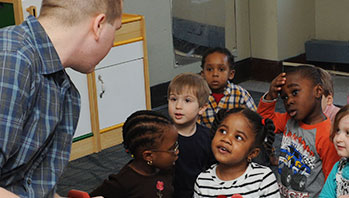- “Plants All Around” chart
- dirt
- plant
MA Standards:
English Language Arts/Speaking and Listening/SL.PK.MA.1: Participate in collaborative conversations with diverse partners during daily routines and play.
English Language Arts/Language/L.PK.MA.1: Demonstrate use of oral language in informal everyday activities.
English Language Arts/Language/L.PK.MA.6: Use words and phrases acquired through conversations, listening to books read aloud, activities, and play.
MA Draft STE Standards
Life Sciences/Ecosystems; Biological Evolution/LS2/4.B: Using their experiences in the local environment and other evidence, raise and discuss questions about the basic needs of familiar organisms and how they might meet their needs. (Clarification statement: basic needs include water, food, air, shelter, and light for most plants)
Head Start Outcomes
Language Development/Receptive Language: Attends to language during conversations, songs, stories, or other learning experiences.
Language Development/Expressive Language: Uses language to express ideas and needs.
PreK Learning Guidelines:
English Language Arts/Language 2: Participate actively in discussions, listen to the ideas of others, and ask and answer relevant questions.
Science and Technology/Living Things and Their Environment 17: Observe and describe how natural habitats provide for the basic needs of plants and animals with respect to shelter, food, water, air, and light.
Talk Together: Observe Underground Changes

© Commonwealth of Massachusetts, Department of Early Education and Care (Jennifer Waddell photographer). All rights reserved.
STEM Key Concepts: Plants get their needs met from the environment (their habitat); Some plant parts are below the ground and some above; Earthworms are animals that live in the soil, underground
ELA Focus Skills: Listening and Speaking, Vocabulary
Have children share their underground environment drawings from yesterday. Share any photos or videos taken. Then gather children around the worm habitat and take off the cover. Discuss the changes that have taken place. Ask children to describe what they see. Ask questions such as,
- How do you think the grass clippings got into the dirt?
- What do you notice that the worms have done to the dirt? How do you think that will help plants?
Have children draw a picture or add to their picture from yesterday to show any changes. Encourage children to dictate as you add new findings to the “Plants All Around” chart.
